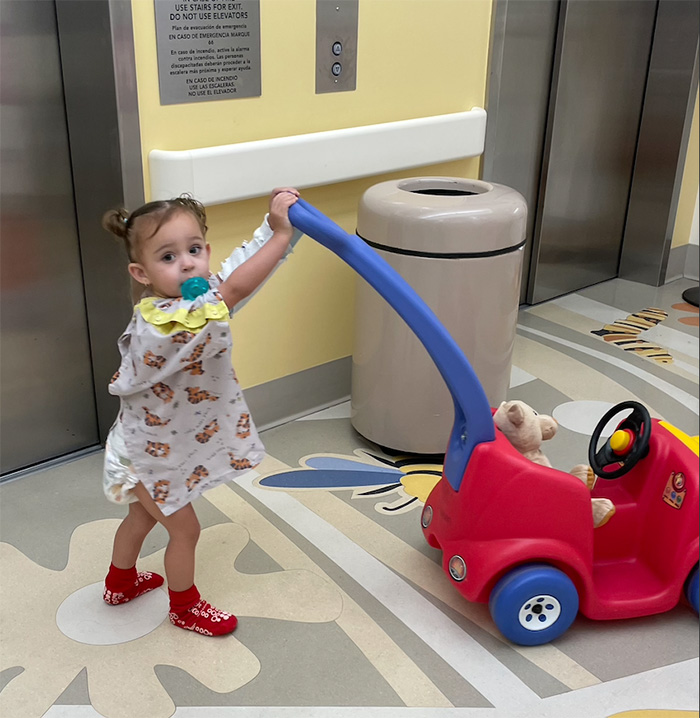Why playing with magnets may be bad for kids, tips for preventing swallowing
A recent 2-year-old’s trip to Julia and George Argyros Emergency Department at CHOC Hospital highlights the dangers of ingesting tiny, high-powered magnets that are included in toy sets.
CHOC patient Luna and her family went through a scary experience when she swallowed four of her brother’s magnet toys. But thanks to the swift and expert intervention from experts at Luna has made a full recovery.
Playing with and swallowing magnets
One night, 2-year-old Luna awoke at 3:30 a.m. with stomach pain. Then, she began vomiting.
Weird, thought her parents, Philip and Patricia.
They racked their brains: What did she eat last night?
Then they remembered: Their son, Gabriel, 12, had seen Luna playing with his set of tiny, strong magnets just before bedtime. The silver magnetic balls – each the size of a BB pellet – can be molded into different shapes. This wasn’t the first time Luna had played with these; her brother had had the magnets for about five years.

“Did you put any of these in your mouth?” Gabriel asked his baby sister.
At a phase when she’s answering “yes” to most questions, Luna responded in the affirmative.
But her parents didn’t worry too much before they slept, thinking if she had, in fact, swallowed one, the tiny magnet likely would pass with no issues.
Seeking medical treatment for magnet ingestion
After Luna repeatedly vomited the next morning, the Luna’s parents called their doctor. He told them to go to urgent care for an X-ray. It showed Luna had swallowed four magnets.
Just like Philip and Patricia thought, the physician said they would likely pass, but suggested they to go to CHOC to be safe.
Dr. Laura Goodman, pediatric general and thoracic surgeon, saw Luna in the ED.
Luna’s X-ray showed the four magnets together, but there was no way for Dr. Goodman to tell if they were in one loop of the intestine, or endangering Luna by sticking together across two different parts of the intestine.

When more than one of these magnets is swallowed, they attract to each other across tissue, cutting off blood supply to the bowel and causing obstructions, tissue necrosis, perforation, sepsis and even death.
Dr. Goodman believed the magnets inside Luna were threatening to perforate her tissue. As she explains, “because of Luna’s degree of pain, I thought the magnets were doing something bad in there, so I decided to operate.”
Emergency surgery needed for magnet removal
Dr. Goodman performed Luna’s surgery on May 11.
“With a small incision, I was able to find the magnets, but in order to pull them out I had to make a small exploratory incision through her belly button, cut open her intestine, and take them out,” Dr. Goodman says, adding that Luna was lucky to have avoided serious injury.
Although one magnet had safely passed to Luna’s rectum, three were in her small intestine and colon. The magnets were stuck across the walls of the different loops of intestines, and if untreated, would have perforated.
The procedure took only 90 minutes, but Luna remained at CHOC for four days. She had to have a gastric tube placed in her stomach to deliver nutrition for a few days after surgery, and it took a couple of days for her to be able to consume liquids.

Philip says Luna’s medical emergency was scary for him, his wife, and his son. But Dr. Goodman and others on her team made things a little easier.
“They were extremely calm and understanding of the situation, and made us feel more comfortable,” Philip says.
Today, Luna is doing fine.
Magnets as stress relievers and toys, documented hazards
Luna’s emergency room visit to CHOC prompted Dr. Goodman to send a message to the U.S. Consumer Product Safety Commission (CPSC) about these magnets. Although they have long been known as one of most dangerous ingestion hazards in children, they remain readily available for purchase online and in gift stores.
Small, high-powered magnet sets showed up as children’s toys in the early 2000s and then later in 2009 as desk toys for office workers to relieve stress and boredom.
Ten times stronger than common household refrigerator magnets, their size and attractiveness (when multicolored, they look like candy) make them a huge hazard for young children.
The CPSC reports that ingestion of these magnets led to 1,700 hospital visits in the U.S. from 2009-2011 — most patients were children. Some required surgery to remove the magnets. A few had permanent damage to the digestive tract. At least one child died, according to the CPSC.
Dr. Goodman hopes her report to the CPSC helps lead to more restrictions on high-powered magnets sold as toys or adult stress relievers.
How to prevent your child from swallowing magnets
Swallowing magnets is a serious, life-threatening matter, says Poison Control.
Prevention is key.
Children often don’t report what they did. Signs and symptoms of swallowing magnets can often be mistaken for a viral illness. They may include nausea, vomiting, abdominal pain and fever.
Here are some tips to avoid accidental ingestion:
- If magnets are used in the home, store them in a locked cabinet or box out of reach of children and pets. Be sure to discard them safely, too.
- Magnet sets should also be kept away from older children and individuals with developmental delay or the elderly with memory impairment. Older children can play with them in their mouths, commonly trying to see if they can separate them with their teeth, leading to accidental swallowing.
- Choose refrigerator magnets that are large enough they cannot be swallowed or pose a choking hazard to children.
- Avoid the use of magnetic beads as fake body piercings.
- After use of magnets, count each piece to make sure none are missing.
If anyone swallows a magnet, here’s what you should do:
- Do not try to make the person throw up.
- Do not give anything to drink or eat.
- Call Poison Control right away at 1-800-222-1222.
Get more expert health advice delivered to your inbox monthly by subscribing to the KidsHealth newsletter here.
Get more safety and injury prevention tips from CHOC experts
More children are affected by injuries than all other childhood illnesses and diseases combined. Most of these injuries are predictable and preventable. Here’s how to keep your child safe.





